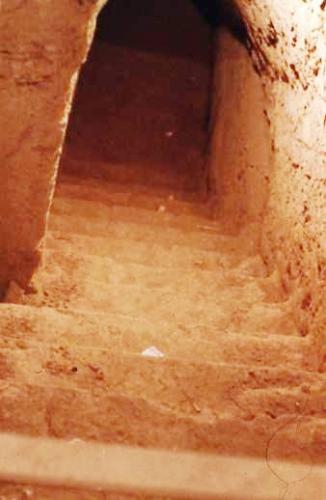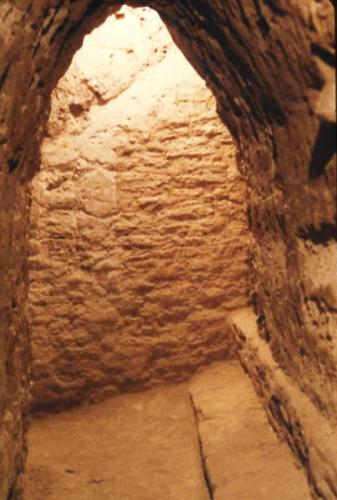The Tunnels
By Geoffrey McCafferty (2008)
The entrance to the Great Pyramid is via a tunnel on the north side. Excavators from the Proyecto Cholula used mining techniques to dig tunnels into the interior of the pyramid in order to identify different phases of construction. So for example, entering from the north visitors pass through several facades from earlier buildings. These are visible as areas of stone masonry covered with cement, but were subsequently encased in adobe brick as fill for a later construction stage. Because the Great Pyramid was made of adobe brick the tunnels are remarkably stable, as opposed to the rubble fill of most other pre-Columbian pyramids. Tunnels that are open to the public feature electrical lighting and run level with the entrance, but other tunnels followed ancient staircases down to the original ground surface (about 10 m below the public tunnel) and up to the top of the early pyramid stages.

Tunnel inside Great Pyramid


Staircase leading down Original step at lower right, note adobe fill
Inside the tunnels of the Great Pyramid excavators found a series of polychrome murals, relating to different construction stages. The earliest were a repeating panel known as the "Chapulines" (grasshoppers), although they more closely represent larval bodies with skeletal heads. Other murals included checkerboard patterns in black and white, and a netted jaguar. The most extensive murals are known as the Bebedores (drinkers), and feature nearly 150 life sized individuals in the process of drinking out of ceramic bowls, while sitting around larger vessels that presumably held the liquid. These figures are arranged in two panels, and appear to be seated on woven rugs or jaguar skins. They wear loin cloths, and have elaborate hairstyles. Some of the individuals appear in the process of transformation into animals, and this has been suggested as evidence that they were imbibing alcoholic and/or hallucenogenic substances, such as pulque. No strong stylistic parallel to the Bebedores exists in Mesoamerica, though there is some similarity to the miniature figures on the Tlalocan mural from Teotihuacan, and to the courtly scenes on Maya polychrome vases. Based on the position of these murals in the construction sequence, and on stylistic elements, they are believed to date to the Epiclassic period (c. 600-800 CE), though more rigorous research needs to be done on this fascinating mural.

Detail from Bebedores mural

